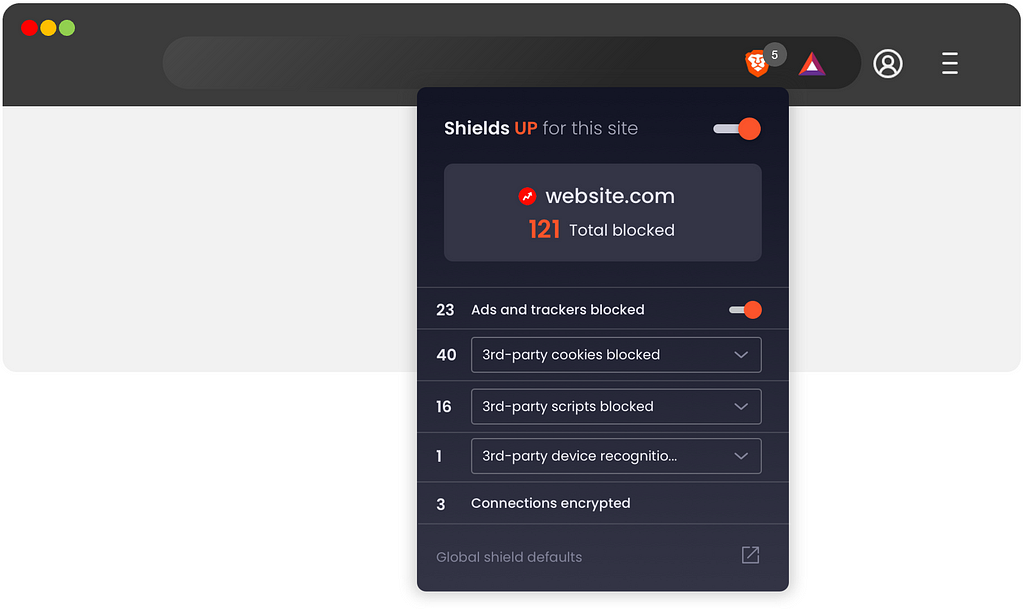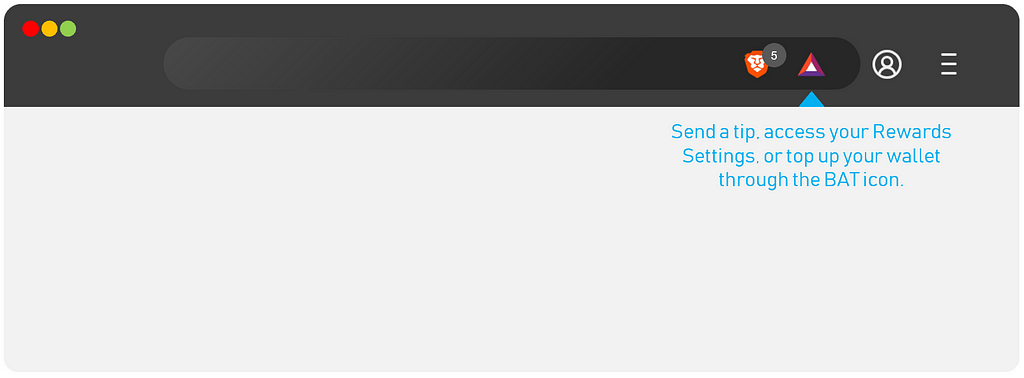Latest news about Bitcoin and all cryptocurrencies. Your daily crypto news habit.
Disclaimer: if this article does convince you to try out Brave, you can download it through my link, and it helps support me as well. All links to Brave Browser downloads in this article are connected to me.
I got interested in Brave initially because of the cryptocurrency aspect of the browser — I had been exploring different applications available today that leverage cryptocurrency. After playing with it for five minutes, though, I discovered that I found a great alternative to Chrome. The best way I know how to describe Brave is that it’s Chrome on steroids. The user experience of Brave mimics Chrome in every way — you can even install Chrome extensions on it. But it takes a step beyond the features available through Chrome today, with a focus on true privacy, user protection, and convenience.
From a cryptocurrency perspective, it is one of the few projects in existence today that I believe has really strong potential not just because of the value proposition, but also because of Brave’s creative way of executing it — through its own native browser. Try Brave Browser for a day or two. You’ll probably forget that you’re not using Chrome.
The interface of the Brave Browser should feel very familiar to you. This shouldn’t come as a surprise, since Brave is built on Chromium, which is an open-source project that was launched by Google; Chromium’s source code is used for Google Chrome.
This means that Brave is able to support most of the features that Google Chrome supports, and is compatible with most extensions on the Chrome Store (to get Chrome extensions, you can just type in brave://extensions into the URL bar of the Brave browser). The shortcuts are the same, too (e.g., CTRL+T to open a new tab). This also means that if you want to switch over from Google Chrome to Brave, you can also 1-click transfer all of your username/password combinations as well as your bookmarks.
No More Need for Potentially Malicious Ad Blocker Extensions
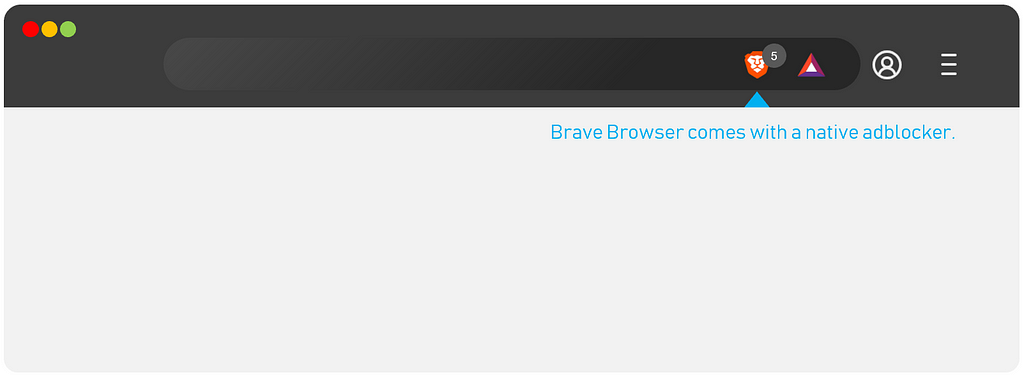 The native ad-blocker on Brave shows you how many ads it blocked directly on the URL bar.
The native ad-blocker on Brave shows you how many ads it blocked directly on the URL bar.
Google Chrome doesn’t come with native ad-blocking capabilities. That being said, the idea of ad blocking isn’t exactly what Google wants in the first place; after all, around 84% of its revenue comes from advertising. On the other hand, Brave comes with an ad-blocker installed.
When you first think about it, the non-native ad-block feature doesn’t seem like a big deal. If Chrome users want to ad-block, they can just download an extension from the Chrome store. Unfortunately, downloading ad-block software isn’t exactly clear. A simple search for an adblock extension on Chrome results in a plethora of different results, most that are indistinguishable from one another apart from a different logo.
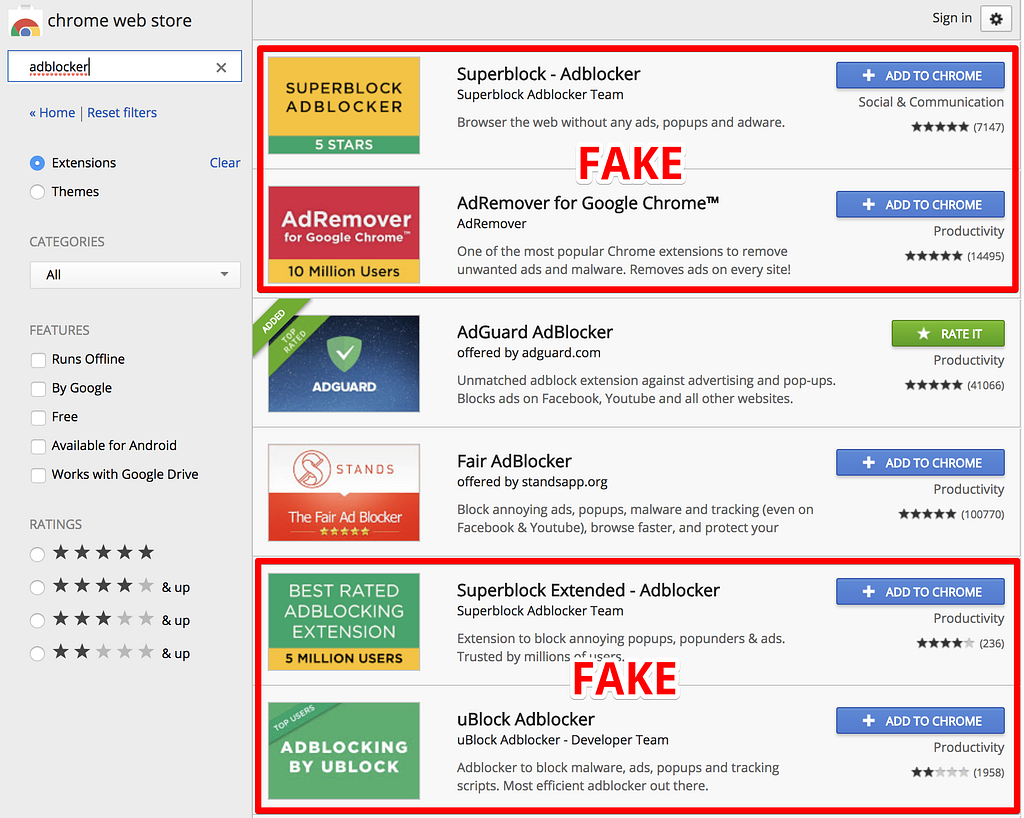 Fake ad-block extensions on Chrome that actually infected your browser with malware. Source: AdBlock
Fake ad-block extensions on Chrome that actually infected your browser with malware. Source: AdBlock
Choosing the wrong ad-block extension can come at a price of being infected with malware. In 2018, a report came out by AdGuard that found five ad-block extensions that also contained malware. Combined, those five extensions also were installed in over 20 million users’ browsers. While apps on the Chrome Webstore undergo an auditing process that should weed out the malicious apps from the harmless ones, there are chances that some slip apps manage to slip through the cracks and find their way into victims’ computers.
Also, even the harmless ad-block extensions do not necessarily block all ads. Take a look at this 2015 article from Business Insider, which states:
Google, Microsoft, and Amazon are paying Adblock Plus huge fees to get their ads unblocked.
By going into the settings of Adblock Plus, users can uncheck the box that allows acceptable ads, but most users are unaware of this setting.
The Lion logo on the right side of the URL bar isn’t just good for blocking ads by default, though. Trackers, unwanted cookies and scripts, and other pieces of code that are meant to try to get your information can be blocked. To be honest, the developer side of me hates that, because it means I get less data on who you are as a user, but the user side of me feels more comfortable that there are less identifiable footprints that point to me.
Google Chrome’s Incognito Mode Is False Privacy; Use Brave’s Native Tor Connectivity Instead
Most people misunderstand what Google Chrome’s Incognito Mode actually does. Described by Google as “browse in private”, users often mistake it as a feature that allows them to leave no fingerprints on the Internet. But if you read the fine print on the front page, you’ll see that user activity might still be visible to: websites you visit, your employer or school, and your internet service provider.
In short, what Incognito Mode and normal privacy browsing does is let you browse websites without leaving much of a trace of your activity on your computer after you’re done — your ISP or your company can still see what you’re looking at. So if your network administrator starts giving you weird looks at work, and you’re wondering if he somehow managed to peak at your Incognito browsing history on niche subreddits, then yes, there is a possibility that he or she actually did see those NSFW videos stream through and yes, he or she does know it went to your computer — your IP address is still visible.
That being said, Incognito Mode does have obvious benefits, but only if you use it correctly. For example, if you’re shopping for a birthday present for your tech-savvy partner, Incognito Mode will ensure that he or she doesn’t figure out your surprise by simply looking through your browser history.
Use Tor on Brave for Better Anonymity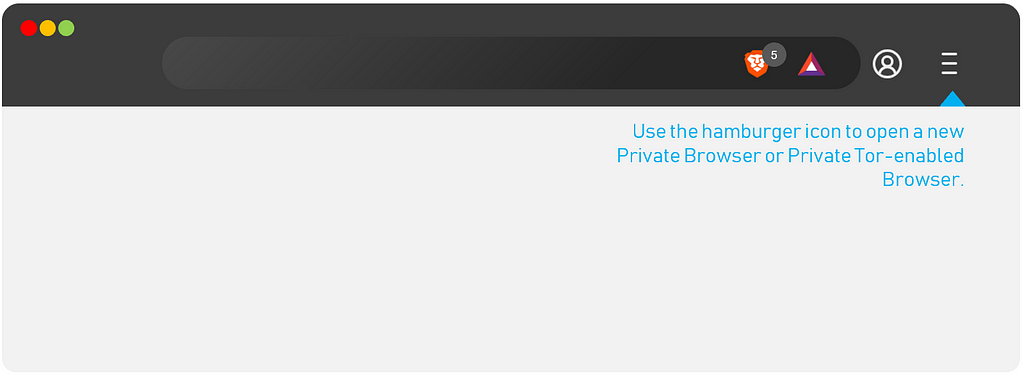
With the shortcut ALT + SHIFT + N (or by clicking on the hamburger icon on the top right of the Brave browser), you’re able to open a new window that’s connected to the Tor network. For users that already use the Tor browser, this is an added benefit because you can use one browser now to do both normal browsing and Tor browsing.
I won’t go into the details of the Tor network, but in a nutshell it basically splits up all the content (images, videos, text, scripts, etc.) from a website to different computers, and then those different computers pass on the pieces to you. This is all done in an encrypted manner, so that your internet service provider or company’s network doesn’t know what is coming through. It’s like communicating in Pig Latin to your sister while you’re both at the dinner table with your parents — you’ll understand each other, but your parents won’t know what you’re saying.
The Tor window opens in Private Mode (Brave’s version of Incognito Mode). This means that you get all of the benefits of incognito browsing as well. You can open an non-Tor private browser by using the traditional Chrome shortcut CTRL + SHIFT + N instead.
Why would you opt for a non-Tor private browser instead of always going Tor? Well, for one, because of the way that the Tor network works (with all the content splitting), it takes a while longer to load a page. Sometimes, it can feel frustratingly long compared to how quickly a web page traditionally loads. So depending on the nature of your browsing and how much you really don’t want your network administrator to know what you’re viewing on your kinkiest subreddits, you may or may not opt in for Tor private browsing.
It Powers the Internet In the Way It Should Be Powered: By the People, Not the Advertisers
I might be biased here because my personal project, Worthyt, started off trying to provide the same value as what the Brave Browser does: allow the Internet user to support content creators all over the Internet through tipping. Since that time, Worthyt has changed into a platform where content creators can field and answer questions from their audience to earn money from them. The pivot was sparked through the same goal: users, rather than advertisers, supporting content creators.
The way Brave accomplishes this is by allowing its users to tip content creators in its native cryptocurrency, Basic Attention Token (BAT). Because a wallet is built into the browser that can store BAT locally, a user doesn’t have to open his or her wallet each time to make a microtransaction; instead, can be done directly on the page you’re visiting, and you can tip by clicking the triangle next to the lion in the browser. You can also use the triangle to get to the Rewards Settings.
In the Rewards Settings, you’ll be able to adjust a few things: Ads, Auto-Contribute, and Tips.
Ads
This is a feature that is still under development by Brave. The idea is simple, though: while ad-block is enabled by Brave by default, users can choose to opt in to view ads. By watching ads, users can earn BAT, which can then be used to support content creators or just to withdraw for fiat or other cryptocurrencies. It’s akin to Twitch Bits, a successful tipping system implemented by Twitch exclusively for its platform. Bits are used to send tips to streamers and can either be purchased or earned by also watching ads.
Auto-Contribute
Auto-contribute is a background-tipping system. By enabling it, you distribute a set amount of BAT to all of the websites that you visit every month, based on the amount of time you spend on the site. You can set the total amount you want to distribute every month, and the browser takes care of calculating all the allocations.
I think this feature can be further flushed out, because it does leave a lot of room for unintentional tipping unless the user manually intervenes in the Settings area. For example, I have been doing some web development for a client, and I visit his existing website to copy over content. I noticed that his website showed up as one of the pages I will be tipping this month — but it’s he who should be tipping me!
It can also negatively impact user experience. Websites that want to earn more BAT can separate their content into multiple pages, which means more clicks and page loads for the user, but also more potential tips for the website. Or maybe it can encourage writers to include more fluff to keep a user’s eyes glued.
Attribution is also a concern right now. For example, if I’m reading an article on the Washington Post, where does the auto-contribute tip go: to the Washington Post, or to the journalist? Depending on the situation, I may want it to go to one or the other.
While Auto-Contribute is an interesting feature that can encourage tipping as a passive habit, I do would like to see the feature more mature before I personally enable it. Also, I probably need more BAT than I have now.
Tips
Tips are more active than Auto-Contribute, as it requires you to remember to send BAT to the creator. That being said, it also allows you to choose where your contributions go, which gives you more control than the Auto-Contribute feature. I personally prefer the Tips feature for now over Auto-Contribute for the reasons I mentioned above.
Because Brave is such a new project, though, its availability to integrate with content platforms is limited. Currently, content creators can only connect and start receiving Brave’s cryptocurrency, BAT, if they are YouTubers, Twitch Streamers, or own their personal blogs. In other words, I can’t take BAT on Medium! If you try to tip me on here, you’ll notice that you’re actually sending a tip to Medium. If you click on my Brave Download link, you’ll see that it says “It’s easy to support Kenny Li on YouTube” because I can’t link my Medium account.
Other Great Features
Stop the Unwanted Video Autoplaying!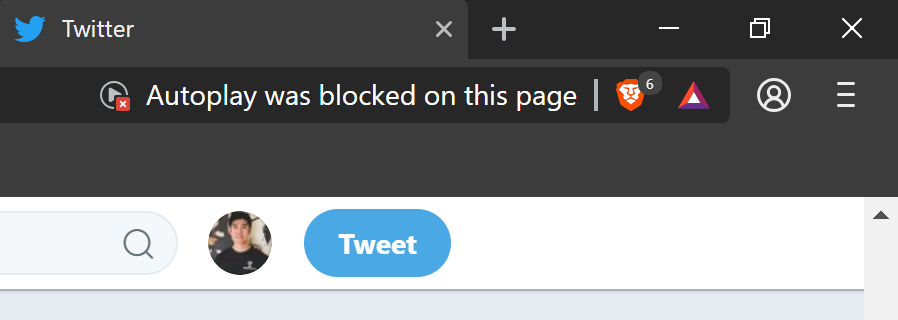
Don’t you hate it when you’re secretly browsing irrelevant websites during class or a meeting and then, suddenly, a loud video starts playing from a website? Brave hates it too. That’s why, by default, it blocks autoplay. Videos that try to start on their own are stopped by the browser; you can turn off this feature in the settings.
Stream Torrents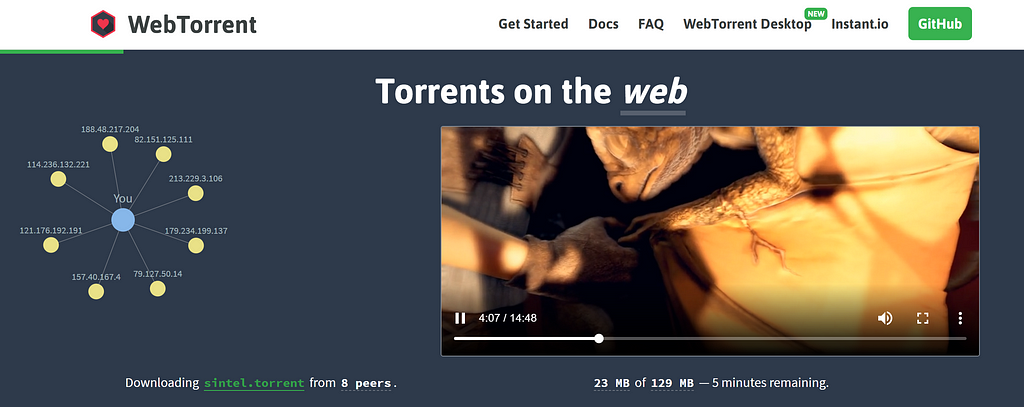 This video is streaming through the Torrent network in Brave Browser.
This video is streaming through the Torrent network in Brave Browser.
Instead of downloading videos, WebTorrent allows you to stream them directly from the Brave, and is a feature that’s built into the browser. The larger implications of this feature include a completely P2P-hosted YouTube; for now, though, you can use it to immediately view videos.
Transfer Over All Your Passwords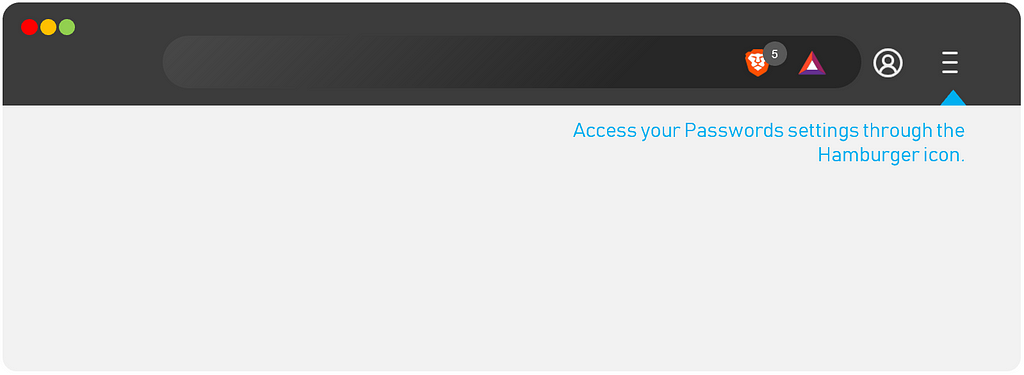
I have multiple different passwords all saved through the Chrome browser, and to be honest, it has been a major factor in preventing me from switching to another browser. With Brave, you can easily transfer over those passwords by clicking on the Person icon (next to the hamburger) and selecting Passwords from the box that pops up. From there, you can import your passwords if you haven’t already.
At its current stage, Brave Browser is a fully functional browser that has a clean and familiar user experience. There is no learning curve, especially if you are coming over from Chrome — you should feel right at home immediately. Most importantly, don’t think of Brave as just another browser — it’s an important piece of a movement to take back the Internet. Try it out for a few days and let me know what you think.
The New Internet Starts with Brave Browser was originally published in Hacker Noon on Medium, where people are continuing the conversation by highlighting and responding to this story.
Disclaimer
The views and opinions expressed in this article are solely those of the authors and do not reflect the views of Bitcoin Insider. Every investment and trading move involves risk - this is especially true for cryptocurrencies given their volatility. We strongly advise our readers to conduct their own research when making a decision.


